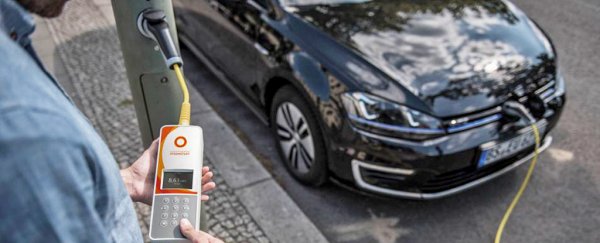For electric cars to really hit the mainstream we need to build better networks of charging points so drivers can 'fill up' more easily – and an ingenious scheme is now underway in London to convert standard streetlights into charging points for vehicles.
All that electric car drivers need is a custom charging cable and a parking space next to one of the adapted lights, with power usage and billing all handled via a connected app. The best part is, most of the infrastructure is already in place.
While the scheme is rolling out in London, the brains behind it come from a German company called Ubitricity, which began converting streetlights in the borough of Hounslow in 2015. More points were recently added in Richmond upon Thames.
"We want our drive to install more charge points across London to translate into greater electric vehicle use and ultimately cleaner air for everyone in the capital," says Ubitricity CEO Knut Hechtfischer.
Here's how it works: first, designated streetlights get converted to LED versions, so they draw less power. The power that's no longer being used to guide people at night can then be used to charge cars, via a socket provided by Ubitricity.
The socket is only compatible with Ubitricity's SmartCable, which prevents anyone and everyone from rocking up to give their smartphones or laptops an extra boost.
Once you've got yourself a SmartCable, you can charge up your vehicle from any of the converted streetlights you like. There's an electricity meter built into the cable too, so you always know how much you're using.
No extra power lines need to be laid, no extra charging boxes need to be built, and drivers get some added reassurance that they won't get caught short with a low battery. Installation of the sockets is quick and relatively cheap, Ubitricity says.
Prices for charging up are in the region of 13 pence per Kilowatt hour, according to a Tesla driver speaking to Fully Charged. That means you could fill up a Tesla Model S for around £13, which works out at about US$17 or AU$22 – enough to get you through about 682 kilometres (424 miles) of driving.
Several other solutions are in the works too, and soon charging your electric vehicle could be as simple as driving down the road: earlier this year researchers from Stanford University figured out how to beam a small amount of electricity into a moving object, which might one day mean you could drive past a charging station to fill up.
Tests have also been carried out in the UK to look at how road surfaces could be adapted to act as continual chargers. Once this kind of technology matures we can enjoy all the benefits of electric cars – low noise, and no polluting fumes.
Of course, there's still the further step of getting the source energy onto renewables to make the entire process as clean and green as possible. London has a very poor record when it comes to renewable energy use.
But making life easier for more electric cars is a great step toward a cleaner future. Cutting vehicle emissions can have a great impact of its own.
"Poor air quality is one of the biggest issues facing London," says Councillor Peter Buckwell from Richmond Council in London, where Ubitricity has recently been helping to upgrade streetlights. "We need to do everything we can to cut vehicle emissions."
"I hope that as we continue to roll out more charging points, even more residents will start buying electric cars. They aren't just good for the environment, they are also good for the pocket."
